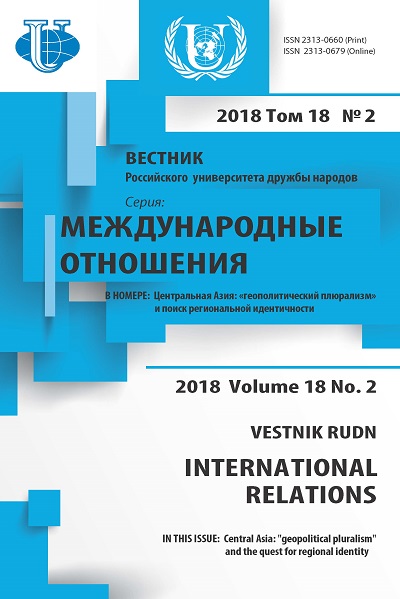CHINESE 2017 BRICS PRESIDENCY: EXPANDING COOPERATION HORIZONS
- Authors: Safonkina E.A.1
-
Affiliations:
- Russian Presidential Academy of National Economy and Public Administration (RANEPA)
- Issue: Vol 18, No 2 (2018): Central Asia: “geopolitical pluralism” and the quest for regional identity
- Pages: 356-367
- Section: INTERNATIONAL ECONOMIC RELATIONS
- URL: https://journals.rudn.ru/international-relations/article/view/18886
- DOI: https://doi.org/10.22363/2313-0660-2018-18-2-356-367
Cite item
Full Text
Abstract
The research aims to analyze the Chinese BRICS presidency in 2017 from the standpoint of promoting adenga’s continuity, developing new initiatives and providing a balance of national and partner countries’ interests in the context of existing and new global challenges. To carry out the research the author applied historical and comparative analysis methods. The author comes to a conclusion that China was able to effectively organize its presidency’s agenda to promote its own initiatives while supplying partners’ demand hereby laying a basis for further cooperation development in the BRICS, first of all in the framework of the South African presidency in 2018. In the economic sphere a number of sectoral documents were approved to exchange experience between the participating countries, in particular the Framework on Strengthening the Economic and Technical Cooperation for BRICS Countries aimed at providing CNY500 million to boost practical cooperation. In the financial sphere, with an objective to promote the Chinese national currency at the international financial markets, China implemented steps aimed at developing cooperation in the monetary sphere that, obviously, in the interests of other BRICS member countries. Chinese national financial institutions broadened their engagement with the BRICS New Development Bank. China faces a wide range of social goals in line with the Sustainable Development Agenda. The Xiamen Declaration affirmed the BRICS members’ commitment to fully implement the Agenda 2030. Being interested in new technologies transfer China promoted an adoption of a long-term cooperation instrument in this sphere (BRICS Action Plan for Innovation Cooperation (2017-2020)). To expand its influence at the international scene China actively uses soft power mechanisms. Its BRICS presidency was not an exception. A wide number of events were organized to promote Chinese culture and language. For the first time the BRICS Sport games took place. In such a way the Chinese 2017 presidency reaffirmed the BRICS mission, adopted new decisions, in particular aimed at cooperation institutionalization, in the interest of China and partner countries.
About the authors
Elizaveta Andreyevna Safonkina
Russian Presidential Academy of National Economy and Public Administration (RANEPA)
Author for correspondence.
Email: safonkina-ea@ranepa.ru
Researcher of the Center for International Institutions Research (CIIR), Russian Academy of National Economy and Public Administration under the President of the Russian Federation (RANEPA)
References
- Chingchit, S. (2016). The Curious Case of Thai-Chinese Relations: Best Friends Forever? The Asia Foundation. URL: https://asiafoundation.org/2016/03/30/the-curious-case-of-thai-chineserelations-best-friends-forever/ (accessed: 12.01.2017).
- Gorbunova, M. & Komarov, I. (2016). A Hybrid Mechanism of Multilateral Economic Cooperationas a New Form of Foreign Policy of China. International Organisations Research Journal (IORJ), 11 (3), 82—98. doi: 10.17323/1996-7845-2016-03-82. (In Russ.).
- Khmelevskaya, N. (2015). The Real Contours and Targets for the BRICS Monetary Partnership to Facilitate Trade and Investments. International Organisations Research Journal (IORJ), 10 (2), 70—88. doi: 10.17323/1996-7845-2015-02-70. (In Russ.).
- Kirton, J. (2013). G20 Governance for a Globalized World. Farnham: Ashgate.
- Kirton, J. & Larionova, M. (2017). Accountability for Effectiveness in Global Governance. London: Routledge.
- Larionova, M.V. (2016). Rossiiskoe predsedatel’stvo v BRIKS: modeli vzaimodeistviya s mezhdunarodnymi institutami [Russia’s 2015 BRICS Presidency: Models of Engagement with International Organizations]. International Organisations Research Journal (IORJ), 11 (2), 113—139. doi: 10.17323/1996-7845-2016-02-113. (In Russ.).
- Larionova, M.V. (2017). G20: Engaging with International Organizations to Generate Growth. International Organisations Research Journal (IORJ), 12 (2), 54—86. doi: 10.17323/19967845-2017-02-54. (In Russ.).
- Larionova, M.V. (2018). G20, BRICS and APEC in the System of International Institutions: A Piece of Good News for Global Governance. International Organisations Research Journal (IORJ), 13 (1), 7—33. (In Russ.).
- Larionova, M. V. (2015). South Africa’s BRICS Presidency: Regional Power at the Helm of a Global Governance Forum. Vestnik RUDN. International Relations, (1), 125—134. (In Russ.).
- Larionova, M.V. & Kolmar, O.I. (2017). The Hangzhou Consensus: Legacy for China, G20 and the World. International Organisations Research Journal (IORJ), 12 (3), 53—72. doi: 10.17323/1996-7845-2017-03-53. (In Russ.).
- Larionova, M.V., Rakhmangulov, M.R., Sakharov, A.G. & Shelepov, A.V. (2014). BRICS: Emergence of Health Agenda. International Organisations Research Journal (IORJ), 9 (4), 102—125. doi: 10.17323/1996-7845-2016-03-99. (In Russ.).
- Larionova, M.V., Rakhmangulov, M.R., Safonkina, E.A., Sakharov, A.G. & Shelepov, A.V. (2013). The Russian Federation G20 Presidency: in Pursuit of a Balance between Fiscal Consolidation and Sustainable Growth. International Organisations Research Journal (IORJ), 8 (4), 122—179. (In Russ.).
- Larionova, M. & Shelepov, A. (2015). Is BRICS Institutionalization Enhancing its Effectiveness. In: The European Union and the BRICS: Complex Relations in the Era of Global Governance. Ed. by M. Rewizorski. Leiden: Springer. P. 39—55. doi: 10.1007/978-3-319-19099-0_4.
- Leksyutina, Y.V. (2016). China in BRICS: first among equal. The Far Eastern Affairs, 5, 11—20. (In Russ.).
- Mikhnevich, S.V. (2014). The Panda in the Dragon’s Service: The Main Directions and Mechanisms of China’s Soft Power Policy. International Organisations Research Journal (IORJ), 9 (2), 95—129. (In Russ.).
- Safonkina, E.A. (2017). India’s 2016 BRICS Presidency. Asia and Africa Today, 7, 15—20. (In Russ.).
- Shelepov, A. (2018). BRICS engagement with international institutions for better governance. In: BRICS and Global Governance. Ed. by J. Kirton, M. Larionova. London: Routledge, 2018. P. 49—69.
- Shelepov, A.V. (2015). BRIKS i mezhdunarodnye instituty: modeli vzaimodeistviya v protsesse osushchestvleniya mnogostoronnego upravleniya [BRICS and International Institutions: Models of Engagement in Global Governance]. International Organisations Research Journal (IORJ), 10 (4), 7—28. (In Russ.).
- Stuenkel, O. (2015). The G7 and the BRICS in the post-Crimea world order. Valdai Papers, № 14. URL: http://www.postwesternworld.com/2015/05/06/brics-crimea-world/ (accessed: 12.05.2017).
- Toloraya, G.D. & Chukov, R.S. (2016). BRICS to Be Considered? International Organisations Research Journal (IORJ), 11 (2), 97—112. doi: 10.17323/1996-7845-2016-02-97. (In Russ.).
- Trifonov, V.I. (2009). Vneshnyaya politika KNR (1949—2009 gg.) [The PRC’s Foreign Policy (1949—2009)]. The Far Eastern Affairs, # 5, 57—70. (In Russ.).











